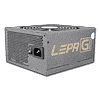 0
0
LEPA G850-MAS 850 W Review
Voltage Regulation & Efficiency »A Look Inside
Before reading this page, we strongly suggest a look at this article, which will help you understand the internal components of a PSU better.Contrary to most of the LEPA G series units, this one is made by Channel Well Technology (CWT) and is, to be more specific, based on CWT's fresh PUQ-G platform. A conventional double forward topology is utilized on the primary side, while a synchronous rectification along with two VRMs for the generation of the minor rails is used on the secondary side. Finally, CWT tried to reduce the production cost by using a single-sided PCB.
We find the first part of the transient filtering stage at the AC receptacle, which, in this case, consists of only a pair of Y caps. The rest of the parts on the main PCB complete the transient filtering stage with two X and two Y caps, two CM chokes, and an MOV.
The two parallel bridge rectifiers are bolted on a dedicated heatsink, and a copper plate is used to cool them down. Their model number is GBU806 and each can handle up to 8 A of current.
In the APFC, two IPW60R190E6 fets are used along with a CREE C3D06060 boost diode. The single hold-up cap (470μF, 400V, 105°C) is provided by Panasonic and is small for the unit's capacity. Finally, the combo PFC/PWM controller is a Champion CM6802 IC, which is an upgraded version of the famous CM6800 offering higher efficiency.
The thermistor, responsible for protection against large inrush currents, is backed up by an electromagnetic relay.
The main switchers are two Infineon IPW60R099C6 fets configured in double forward topology. On the same heatsink, we also found a STF3NK80Z fet that we suspect of being utilized by the 5VSB rectification circuit.
On the secondary side, synchronous rectification is used, and the +12V rail rectify five IPD031N06L3 fets. Like every other PUQ platforms we examined in the past, this one doesn't use a heatsink to cool down the +12V fets. The PCB that houses them handles this job with the help of the PSU's fan and three bus bars on its solder side.
All electrolytic caps on the secondary side are provided by Nippon Chemi-Con and are rated at 105°C. We also found a single polymer cap.
The WT7502 supervisor IC is hidden by a jungle of wires. It only offers basic protections, excluding OCP for the +12V rail, which is fine since OCP in a single +12V rail PSU of such high capacity is useless anyway.
The VRMs that generate the minor rails are installed directly on the modular PCB for lower voltage drops. The common PWM controller for both VRMs is an APW7159 IC, and a pair of AP72T03GH fets is used with each one.
At the front of the modular PCB, we find many polymer filtering caps. The big ones with the pink markings are from Enesol. Unfortunately, we couldn't identify the rest with purple and red markings.
The main PCB features a decent soldering quality, which is, however, still far away from high-end implementations. It won't cause any problems and will allow the PSU to deploy its full performance. We, to our great satisfaction, didn't spot any long component leads.
The cooling fan is provided by Yate Loon Electronics and its model number is D14BH-12 (12V, 0.7 A, 2800 RPM, 140 CFM, 48.5 dBA max). It is quite strong since it has to cool the +12V fets down mostly on its own. It is quiet noisy at increased RPMs.
Feb 26th, 2025 12:45 EST
change timezone
Latest GPU Drivers
New Forum Posts
- Post your 7-Zip v22.01 scores (411)
- What local LLM-s you use? (72)
- Are the two M.2 pcie Gen4 x4 slots on my Zen 4 8845HS Socket FP8 Mini-PC equal? (6)
- Intel i7-7700hq undervolt for ntb (3)
- Advice needed for buying a new PSU (17)
- TPU's GPU Database Portal & Updates (388)
- AM3 build, uses in 2025 (2)
- How many fans? (29)
- revisiting hpet bcdedit tweaks: what are your timer bench results and settings? (101)
- Windows 11 General Discussion (5707)
Popular Reviews
- Corsair Xeneon 34WQHD240-C Review - Pretty In White
- ASUS GeForce RTX 5070 Ti TUF OC Review
- Corsair Virtuoso MAX Wireless Review
- MSI GeForce RTX 5070 Ti Ventus 3X OC Review
- MSI GeForce RTX 5070 Ti Vanguard SOC Review
- MSI GeForce RTX 5070 Ti Gaming Trio OC+ Review
- darkFlash DY470 Review
- Gigabyte X870 Aorus Elite WiFi 7 Review
- AMD Ryzen 7 9800X3D Review - The Best Gaming Processor
- Gigabyte GeForce RTX 5090 Gaming OC Review
Controversial News Posts
- NVIDIA GeForce RTX 50 Cards Spotted with Missing ROPs, NVIDIA Confirms the Issue, Multiple Vendors Affected (495)
- AMD Radeon 9070 XT Rumored to Outpace RTX 5070 Ti by Almost 15% (304)
- AMD Plans Aggressive Price Competition with Radeon RX 9000 Series (274)
- AMD Radeon RX 9070 and 9070 XT Listed On Amazon - One Buyer Snags a Unit (247)
- NVIDIA Investigates GeForce RTX 50 Series "Blackwell" Black Screen and BSOD Issues (244)
- Edward Snowden Lashes Out at NVIDIA Over GeForce RTX 50 Pricing And Value (241)
- AMD Denies Radeon RX 9070 XT $899 USD Starting Price Point Rumors (239)
- AMD Radeon RX 9070 and 9070 XT Official Performance Metrics Leaked, +42% 4K Performance Over Radeon RX 7900 GRE (186)


































